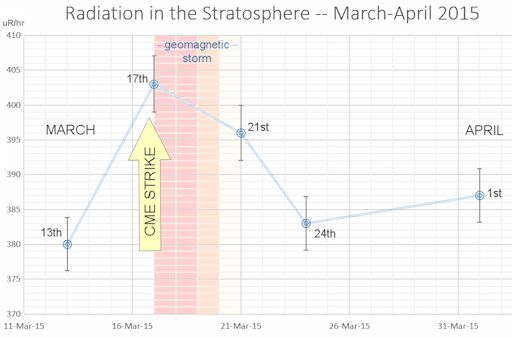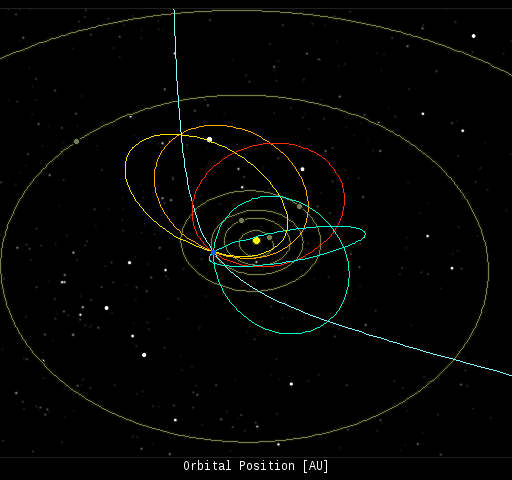Come to Tromsø and share Marianne's passion for rural photography: Chasethelighttours.co.uk invites you to experience "Heaven on Earth" with an aurora, fjord, fishing, whale watching, photography or sightseeing tour. | | |
A NEW SUNSPOT EMERGES: A new and potentially significant sunspot is emerging over the sun's northeastern limb: image. Amateur astronomers with solar telescopes are encouraged to monitor the large active region as it turns toward Earth this weekend. Solar flare alerts: text, voice
REFLECTIONS OF VENUS: How bright is Venus? Just look at the snow in this picture taken April 9th by Giorgia Hofer from a mountaintop in Belluno, Italy:

Hofer went outside after sunset to watch the ongoing conjunction between Venus and the Pleiades (note the star cluster just above Venus in Hofer's photo) "I set up my camera on Giau Pass over Cortina d'Ampezzo," she says. "Venus created a reflection of its light on the frozen snow "
Among all the stars and planets in the night sky, only the Moon is brighter than Venus. Because of its intensity, Venus can do things normally reserved for the sun and Moon--such as casting shadows or making snowy reflections.
When the sun goes down tonight, step outside for your own Venus experience. Look west as the sky fades to black. The glaring Goddess of Love is only 2.5o from the Seven Sisters. It's a nice way to end the day.
Realtime Space Weather Photo Gallery
GOODBYE WINTER, HELLO SUMMER: Around the Arctic Circle, the summer sun is rising and, as a result, night is disappearing. "Our seasons are changing," says Thomas Kast of Siikajoki, Finland, who photographed the transition on April 10th:

"Just a week ago, the Gulf of Bothnia was still completely frozen here," says Kast. "Now only the ice in the boat marina (on the left side of the photo) is still intact. If you look closely on the right side of the photo, you will see a wobbly line from ice floes drifting in the waves."
"On the horizon, the afterglow from the sunset was visible for many hours," he adds. "Due to the aftereffects of the G2-class geomagnetic storm, auroras were visible to the eye very early."
This photo says it all: "Goodbye winter, hello summer."
Realtime Aurora Photo Gallery
UPSIDE DOWN FORBUSH DECREASE: Last month, on March 17th, a CME hit Earth's magnetic field, sparking the strongest geomagnetic storm of the current solar cycle. Spaceweather.com and the students of Earth to Sky Calculus launched a series of weather balloons--before, during and after the storm--to measure the storm's effect on Earth's upper atmosphere. Here are the results:

During the storm, which lasted for more than two days, cosmic radiation levels in the stratosphere jumped by more than 6%. Radiation levels did not return to normal until a week after the CME strike.
Six percent might not sound like a big increase, but consider the following: Atmospheric radiation levels usually decrease when CMEs sweep past Earth. The effect is called a "Forbush Decrease," named after American physicist Scott Forbush who studied cosmic rays in the early 20th century. Essentially, CMEs sweep aside some of the cosmic rays that surround our planet, causing radiation levels to drop. In Sept. 2014, for instance, our space weather ballooning program detected a sharp Forbush Decrease. A 6% increase--simply because it is an increase--therefore comes as a surprise.
The reason for the jump may lie in the intensity of the St. Patrick's Day geomagnetic storm. While Earth's magnetic field was reverberating on March 17th, high-energy particles normally trapped around Earth's poles spilled down to mid-latitudes where the space weather balloons were launched (from the Sierra Nevada mountains of California). These extra particles could have filled in the deficit and overflowed it, producing an "upside down Forbush Decrease."
These results show that we still have a lot to learn about the response of Earth's atmosphere to solar storms. Stay tuned for more results from the ballooning program.
For specialists: Radiation levels plotted above represent the peak of the Pfotzer maximum, located approximately 65,000 feet above Earth's surface. Each space weather balloon carried four independent radiation detectors sensitive to gamma-rays and ionizing particles in the energy range 10 keV to 20 MeV.
Realtime Eclipse Photo Gallery
Realtime Comet Photo Gallery
Every night, a network of NASA all-sky cameras scans the skies above the United States for meteoritic fireballs. Automated software maintained by NASA's Meteoroid Environment Office calculates their orbits, velocity, penetration depth in Earth's atmosphere and many other characteristics. Daily results are presented here on Spaceweather.com.
On Apr. 11, 2015, the network reported 7 fireballs.
(7 sporadics)

In this diagram of the inner solar system, all of the fireball orbits intersect at a single point--Earth. The orbits are color-coded by velocity, from slow (red) to fast (blue). [Larger image] [movies]
Potentially Hazardous Asteroids (
PHAs) are space rocks larger than approximately 100m that can come closer to Earth than 0.05 AU. None of the known PHAs is on a collision course with our planet, although astronomers are finding
new ones all the time.
On April 11, 2015 there were potentially hazardous asteroids.
Notes: LD means "Lunar Distance." 1 LD = 384,401 km, the distance between Earth and the Moon. 1 LD also equals 0.00256 AU. MAG is the visual magnitude of the asteroid on the date of closest approach. | | The official U.S. government space weather bureau |
| | The first place to look for information about sundogs, pillars, rainbows and related phenomena. |
| | Researchers call it a "Hubble for the sun." SDO is the most advanced solar observatory ever. |
| | 3D views of the sun from NASA's Solar and Terrestrial Relations Observatory |
| | Realtime and archival images of the Sun from SOHO. |
| | from the NOAA Space Environment Center |
| | the underlying science of space weather |

